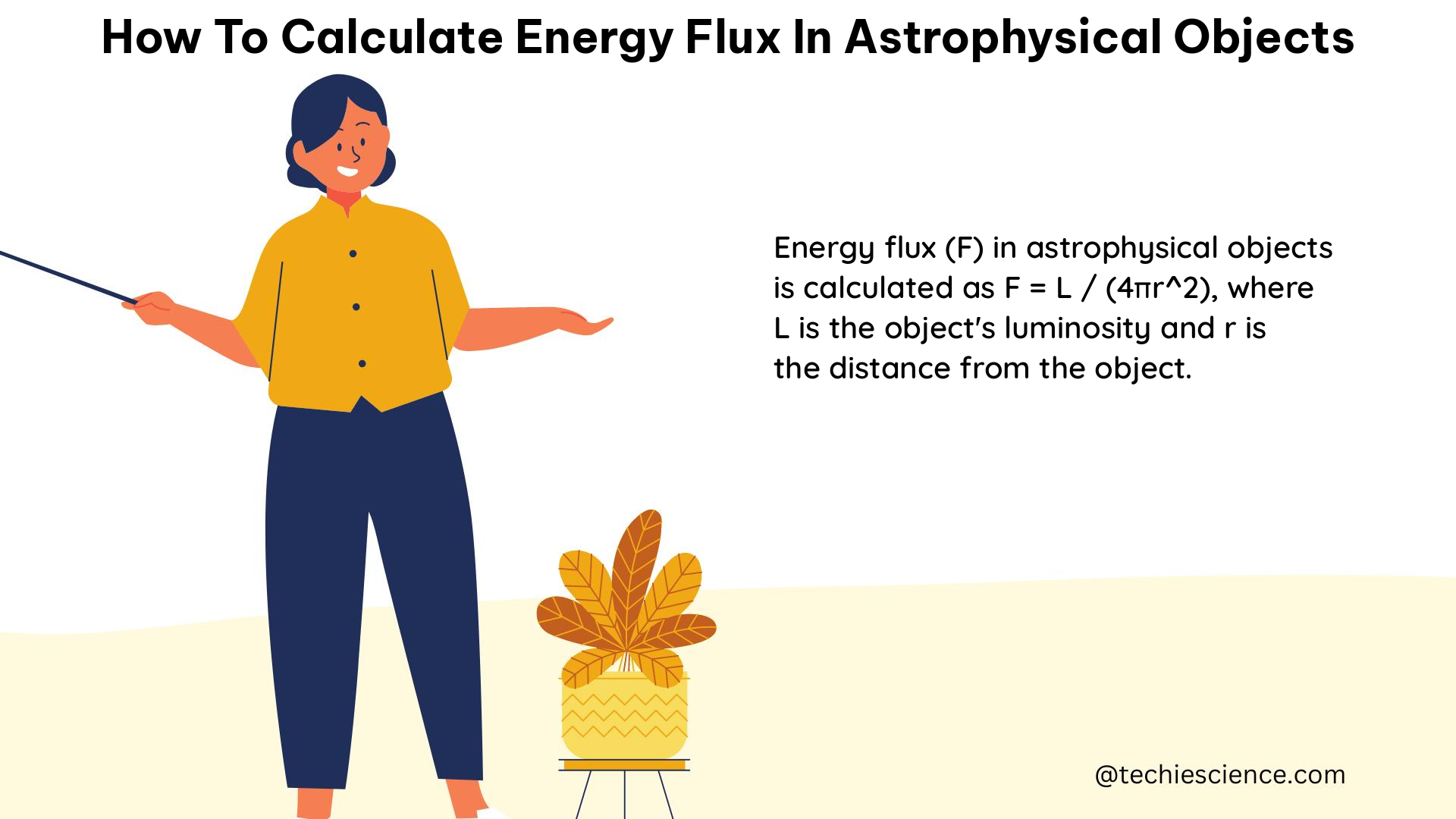Calculating the energy flux in astrophysical objects is a fundamental process in understanding various celestial phenomena, such as the energy output of stars, the interaction of radiation with the interstellar medium, and the behavior of active galactic nuclei. This comprehensive guide will provide you with the theoretical background, formulae, examples, and numerical problems related to calculating energy flux in astrophysical objects.
Theoretical Background and Formulae
Energy flux, denoted as F, is defined as the amount of energy passing through a unit area per unit time. In astrophysics, it is typically measured in units of erg cm^-2 s^-1 or W m^-2. The energy flux can be calculated using the following formula:
F = dE/dAdt (1)
where dE is the amount of energy, dA is the surface area, and dt is the time interval.
In the context of astrophysical objects, energy flux is often associated with the luminosity (L) of a source, which is the total amount of energy emitted per unit time. The luminosity can be related to the energy flux by the inverse square law, which states that the energy flux decreases as the distance from the source increases. Mathematically, this can be expressed as:
F = L/(4πd^2) (2)
where d is the distance from the source.
When dealing with spectrally resolved radiation, the energy flux can be expressed as a function of frequency (ν) or wavelength (λ). The spectral energy flux (Fν or Fλ) is defined as the amount of energy passing through a unit area per unit time per unit frequency or wavelength. The total energy flux can be obtained by integrating the spectral energy flux over all frequencies or wavelengths:
F = ∫Fν dν = ∫Fλ dλ (3)
Examples and Numerical Problems

Example 1: Calculating Energy Flux from a Star
Consider a star with a luminosity of L = 1010 L⊙ (where L⊙ is the solar luminosity) at a distance of d = 10 pc (parsecs). Using equation (2), we can calculate the energy flux as:
F = (1010 L⊙) / (4π(10 pc)^2) ≈ 7.96 × 10^7 erg cm^-2 s^-1 (4)
Example 2: Calculating Spectral Energy Flux
To calculate the spectral energy flux, we need additional information about the star’s spectral energy distribution. For simplicity, let’s assume the star emits as a blackbody with an effective temperature of Teff = 5500 K. The spectral energy distribution can be calculated using Planck’s law:
Fν = (2hν^3/c^2) / (exp(hν/kTeff) – 1) (5)
where h is Planck’s constant, c is the speed of light, and k is Boltzmann’s constant.
Using equation (5), we can calculate the spectral energy flux at various frequencies and integrate over all frequencies to obtain the total energy flux. This process can be performed using numerical methods, such as numerical integration or Monte Carlo simulations.
Numerical Problem 1:
A young, massive star has a luminosity of 1 × 10^6 L⊙ and is located at a distance of 500 pc from Earth. Calculate the energy flux received at Earth.
Given:
– Luminosity, L = 1 × 10^6 L⊙
– Distance, d = 500 pc
Using equation (2):
F = L/(4πd^2)
F = (1 × 10^6 L⊙) / (4π(500 pc)^2)
F = 1.59 × 10^3 erg cm^-2 s^-1
Numerical Problem 2:
A supernova explosion has a peak luminosity of 5 × 10^9 L⊙ and is observed at a distance of 20 Mpc (megaparsecs). Calculate the energy flux received at the peak of the supernova’s light curve.
Given:
– Luminosity, L = 5 × 10^9 L⊙
– Distance, d = 20 Mpc
Using equation (2):
F = L/(4πd^2)
F = (5 × 10^9 L⊙) / (4π(20 Mpc)^2)
F = 1.98 × 10^-3 erg cm^-2 s^-1
Technical Specifications
Calculating energy flux in astrophysical objects requires accurate measurements of luminosity, distance, and spectral energy distribution. These measurements can be obtained using various techniques, such as:
- Photometry: Measuring the total amount of energy received from a source.
- Spectroscopy: Measuring the source’s spectral energy distribution.
- Interferometry: Measuring the size and shape of astrophysical objects, which can help constrain the distance and luminosity.
In addition to observational techniques, theoretical models and simulations are often used to estimate the energy flux in astrophysical objects. These models can account for various physical processes, such as radiative transfer, hydrodynamics, and magnetic fields, which can affect the energy output and propagation.
References
- Sobral’s Astronomy Outreach & Science. (2022, January 12). Energy in Astrophysics: Luminosity, Flux, Flux Density and an Example [Video]. YouTube. https://www.youtube.com/watch?v=FurlrIsTago
- Ransom, S. M. (n.d.). Chapter 2: Radiation Fundamentals. In Radiation Fundamentals (Web). National Radio Astronomy Observatory. https://www.cv.nrao.edu/~sransom/web/Ch2.html
- Cloudy Nights. (2024, April 21). Formula for Magnitude to Photon Flux [Forum post]. Cloudy Nights. https://www.cloudynights.com/topic/919643-formula-for-magnitude-to-photon-flux/

The lambdageeks.com Core SME Team is a group of experienced subject matter experts from diverse scientific and technical fields including Physics, Chemistry, Technology,Electronics & Electrical Engineering, Automotive, Mechanical Engineering. Our team collaborates to create high-quality, well-researched articles on a wide range of science and technology topics for the lambdageeks.com website.
All Our Senior SME are having more than 7 Years of experience in the respective fields . They are either Working Industry Professionals or assocaited With different Universities. Refer Our Authors Page to get to know About our Core SMEs.